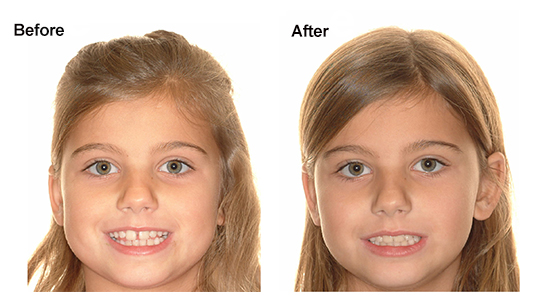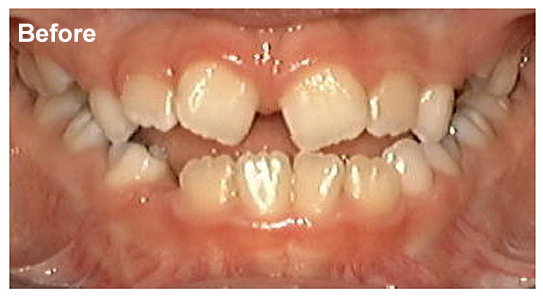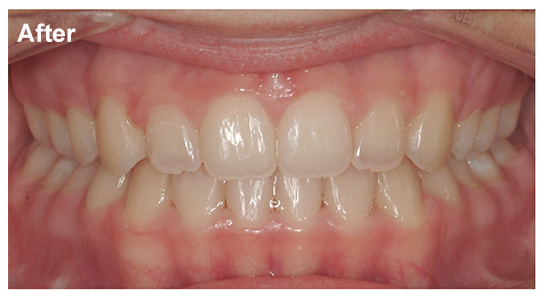October 31st, 2016

WE DON’T think much in our daily lives about being a walking, talking human skeleton. When our orthodontist shows us our lateral cephalogram radiograph for the very first time, it can be quite surprising to see our actual skull and skeleton.

The lateral cephalogram is analyzed by orthodontists for the diagnosis of facial soft tissues influenced by the underlying jaw bone and teeth. Using this analysis, orthodontists produce the beautiful profiles and deliver desires facial esthetics.
Lateral Cephalograms Help Find Certain Bite Issues
When there is a big overjet, overbite, or underbite of the teeth, the lateral cephalometric analysis helps the orthodontist determine which jaw or teeth are responsible for the situation. The analysis of this X-ray can help determine what type of treatment is necessary and whether or not jaw surgery or extractions are needed.

The lateral cephalogram allows the orthodontist to evaluate front tooth position in bone. This helps decide final tooth position for the most stable, beautiful, and functional result. In addition, this analysis indicates whether or not teeth need to be extracted for ideal periodontal health.

The lateral cephalometric analysis gives the orthodontist information about vertical face height and lower jaw angle. This helps decide what treatment mechanics to use to keep the bite functional, beautiful, and closed.

The Lateral Cephalogram Is Critical For Ortho Evaluation
The lateral cephalogram and it's analysis is critical for a thorough orthodontic evaluation. Ask your orthodontist to see your lateral cephalogram radiograph and explain your analysis. Your life may never be the same after the day you realize you are a walking, talking skeleton.
This blog was written by Dr. Ann Marie Gorczyca, Gorczyca Orthodontics, Antioch, California www.clubbraces.com (925) 757-9000. To find an orthodontist near you, visit the American Association of Orthodontists at www.mylifemysmile.org.
Tags: orthodontist, orthodontics, braces, openbite, overbite, overjet, Underbite, facial esthetics, skeleton, Lateral cephalogram, lateral ceph, cephalometrics, dental radiology, imaging, tooth position, jaw position, cephalometric analysis, orthodontic analysis, soft tissue analysis, soft tissue, soft tissue profile, beauty esthetics, beauty, esthetics, facial profile
Posted in Blog | No Comments
June 22nd, 2016

WE'VE ALL HEARD the proverb "Like father, like son" to describe the likelihood that a son will have traits like his father in adulthood. This is especially true when it comes to the genetics of jaw growth and need for orthognathic surgery.
Many young men ages 21 and older pursue correction of jaw imbalances during college or shortly after their college years. What frequently happens is Dad then follows with his own orthoganthic surgery. Now, it is "like son, like father."

Orthoganthic Surgery Can Improve Your Bite
When fathers see the beautiful results of their son's orthodontic/orthognathic surgery treatment, they start to think how nice it would be to have their own bite corrected.

Often, a jaw is advanced by orthognathic surgery. This not only corrects the bite, such as a crossbite, but also opens the airway helping to improve breathing and reduce sleep apnea.

A Corrected Bite Opens A Variety Of Options
Once a crossbite is corrected, it is now possible to have crowns and veneers done on the front teeth. Eating will be easier, and you will look gorgeous and feel great.

Orthognathic surgery is usually covered 100% by medical insurance with the exception of a small co-payment. Patients may stay overnight in the hospital and one to three weeks of work medical leave is taken. Patients are usually able to move their jaws after surgery and wear upper jaw lower jaw rubber bands while eating a soft diet for a few weeks of recovery.

If your apple hasn't fallen far from your tree and you would also benefit from orthognathic jaw surgery, call us at Gorczyca Orthodontics in Antioch, California 925-757-9000. Find us at www.clubbbraces.com.
Board certified orthodontist Dr. Ann Marie Gorczyca and team have completed hundreds of successful orthognathic surgery cases with comfort. We will complete your orthodontic/orthognathic surgery treatment as gently and quickly as possible.
We know your child was a "chip of the old block." It's never too late to do a little "old block" reshaping.
Tags: Antioch, orthodontics, braces, Gorczyca Orthodontics, California, crossbite, Adult orthodontics, anterior crossbite, jaw surgery, orthognathic surgery, Smile Makeover, veneers, Underbite, crowns, sleep apea
Posted in Blog | No Comments
September 9th, 2015

SEVEN IS THE PERFECT AGE for a child’s first orthodontic examination. Screening at age seven assures that your child’s smile will be healthy and look it’s best for the longest time possible.
Early Detection Can Help Long-term Orthodontic Health
Orthodontic treatment at age seven can minimize the need for more extensive procedures such as extraction of permanent teeth in the future. Straight teeth at age seven will also help with your child's self-esteem— a fragile asset that’s so important when growing up.

What to Expect at the Seven Year Orthodontic Exam
At the seven year orthodontic exam, your orthodontist will evaluate:
1. Overjet and facial profile
2. Overbite and jaw function
3. Underbite and tooth wear
4. Openbite, breathing, and oral habits
5. Crowding, spacing, rotations and tooth alignment
6. Symmmetry and facial balance
7. Crossbite and functional shifts
Be sure to seek early treatment if your child has:
1. Snoring or mouth breathing
2. Difficulty chewing, cheek biting, or jaw shifting
3. Thumb sucking, lip biting, or finger habits
4. Crowding or missing teeth
5. Speech problems
6. Grinding or excessive tooth wear
7. Crooked, spaced, or crowded teeth

This case was treated by Board Certified orthodontist Dr. Ann Marie Gorczyca of Antioch, California. Find us at www.clubbraces.com or call us at (925)757-9000 for a complimentary orthodontic evaluation. To find an orthodontist near you, visit the American Association of Orthodontists at www.mylifemysmile.org.
Give your child a great smile. For your child's first orthodonic exam, seven is the magic number.
Tags: Antioch, orthodontist, extraction, orthodontics, braces, Gorczyca Orthodontics, California, overbite, overjet, straight teeth, Underbite, crowding, seven, orthodontics treatment, age seven, first orthodontic exam, spacing, rotations, tooth alignment
Posted in Blog | No Comments
August 25th, 2015

WITHIN FAMILIES, it’s obvious that facial features are hereditary. The best known example is the Habsburg Family, a royal family with large lower jaws.
Anterior crossbites, openbites, or both are seen in parents and grandparents, aunts and uncles, siblings, and cousins of large lower jaw patients. Inheritance is strong. In a recent study, the heritability of mandibular prognathism (large lower jaw) was estimated to be 0.316 and autosomal dominant, suggesting a major gene influences large lower jaw growth.

Large lower jaws are present as early as age 7. This is why when your orthodontist sees an underbite or openbite with a large lower jaw, they will do an in-depth analysis of jaw growth as well as take a careful family history for large lower jaw, called Class III skeletal malocclusion.

Genetically programmed large lower jaw growth cannot be prevented. Maxillofacial surgeons have been doing large lower jaw surgery for decades and often do several hundred per year. This surgery may be done at age 16 in females and age 21 in males. Your orthodontist can take a hand-wrist film to look at radius bone growth completion to determine the best time for orthognathic surgery (jaw surgery).

This case was treated by board certified orthodontist Dr. Ann Marie Gorczyca of Gorczyca Orthodontics, Antioch, CA. Find us at www.clubbraces.com or call us at (925) 757-9000 to schedule a complimentary jaw assessment.
Find out if you have the royal jaw. If you would like a commoner smaller lower jaw, we're here to help.
Tags: openbite, anterior crossbite, Class III, maxillary advancement, orthognathic surgery, large lower jaw, prognathism, mandibular prognathism, skeletal class III, Class 3, Underbite, maxillofacial surgeon, mandibular setback, hand wrist film, skeletal malocclusion
Posted in Blog | 1 Comment

























